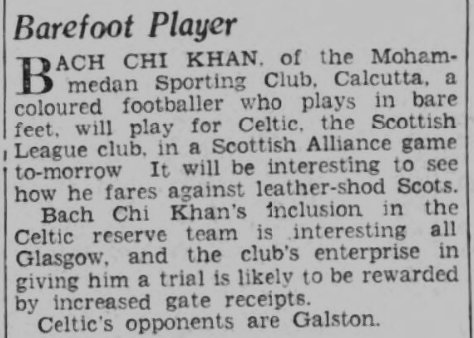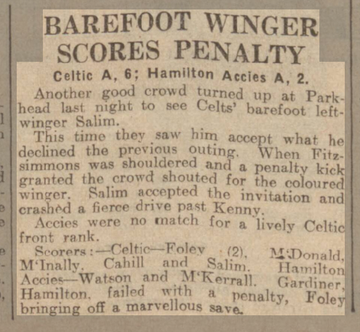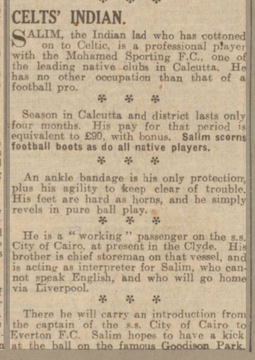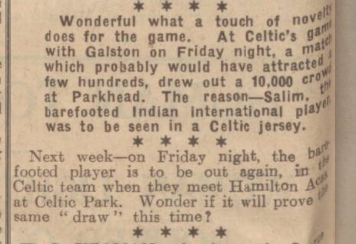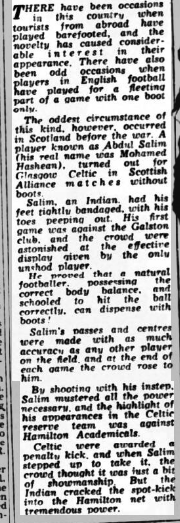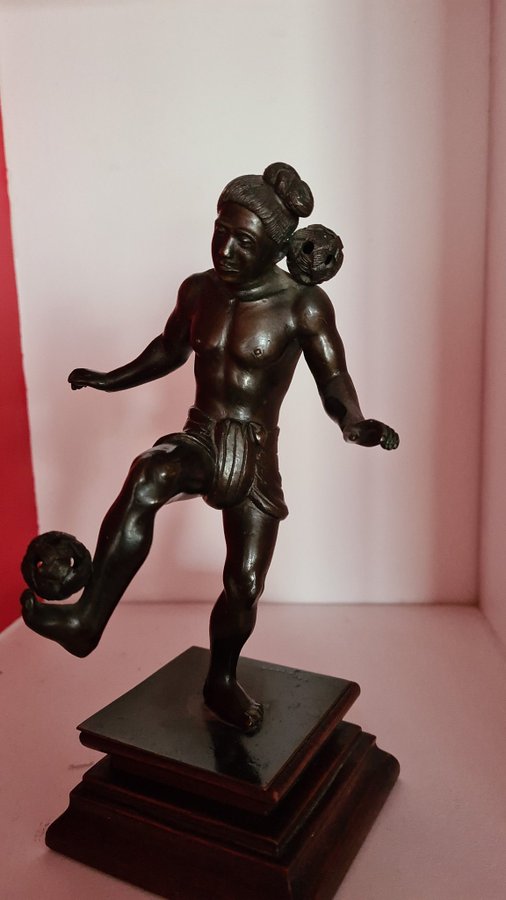S | Player Pics | A-Z of Players
Personal
Fullname: Mohammed Abdul Salim Bachi Khan
aka: Mohammed Salim, Abdul Salim, the Indian Juggler, Bachi Khan
Born: 1904
Died: 5 November 1980
Birthplace: Calcutta, West Bengal, India
Signed: 1936
Left: 1936
Position: Striker/Midfield
Internationals: none
Biog
| “It shows how in the days of the Empire, Celtic broke barriers, living up to the ideal of the civilising mission and how this Indian in bare feet enchanted one half of Glasgow.” Boria Majumdar, deputy editor of the International Journal of the History of Sport |
Mohammed Salim has a notable cult following at Celtic, yet he never played a first team match for the club in a competitive match. This is as he has the great attribute to be heralded as the first Indian to play for any European Club in Europe, and in his own way he helped to break down barriers. His small footnote in footballing history in many ways has greater significance than some may now realise. It is also another example of Celtic manager Willie Maley practicing his mantra of that it is the man and not his colour or creed that matters.
Born & raised in Calcutta in India, Mohammed Salim made a name for himself locally for the Mohammedan Sporting Club that was monopolising the local league. Having been invited to Europe by his cousin, in time he travelled with him to Glasgow:
“A great player from India has come by ship. Will you please take a trial of his? But there is a slight problem. Salim plays in bare feet”.
Willie Maley is said to have laughed in reply and signed him up after a trial that saw Mohammed Salim impress all despite playing in bandaged bound feet (no boots!).
The ‘Indian Juggler‘ as he was dubbed, impressed in trial & friendly matches, and was a small media obsession as the ‘novelty‘ of his background created interest.
He played only two ‘A’ (reserve) matches, hence his omission from certain Celtic reference books. His first appearance came against Hamilton Accies, over whom Celtic triumphed 5-1, and the second against Galston, which was also won by a large margin, 7-1. The Daily Express wrote on his performance v Galston:
“Ten twinkling toes of Salim, Celtic FC’s player from India, hypnotised the crowd at Parkhead last night. He balances the ball on his big toe, lets it run down the scale to his little toe, twirls it, hops on one foot around the defender”.
However, after a short time in Scotland, he wasn’t adapting and became homesick. He was persuaded to hang on and stay, Willie Maley even offering up a charity match to raise funds to assist. Mohammed Salim had the money donated to local charities, a great mark of the man (although he may not initially have realised the sums involved).
If he had remained at Celtic for even a short while longer he would have possibly had the great honour to have played for Celtic in a league title victory (season 1937/38), sadly to be Celtic’s last for many years thereafter. He could even have played in the Empire Exhibition Cup tournament which Celtic won in 1938, which would have been interesting if he had performed highly in the respective games.
As war was to begin a couple of years later, possibly his decision to leave in 1937 was in retrospect to be a prudent one as else it could have been difficult to try to return home in that new environment.
Despite having left Celtic with no major silverware, matches or much else of major note on the field, he still remained in the minds of the Celtic support. Later in life, his son Rashid wrote to Celtic requesting help as his father needed funds for treatment, and Celtic did not disappoint, providing the help he needed with financial assistance. Rashid was so humbled he never did bank the cheque, and saved it for life.
Mohammed Salim passed away in 1980 and even in Indian football circles the significance of his stay at Celtic has been a bit overlooked, something that hopefully will be rectified in time as the game grows in interest in the cricket obsessed nation.
Playing Career
No competitive first team games with Celtic.
Honours with Celtic
none
Pictures
Links
External Links
- Mohammed Salim biography: Indian football Hall of Fame
- Wikipaedia Entry: Biography for Mohammed Salim
- Poem/Ode: Football Poets
- Goal.com:Mohammed Salim – The First Indian to play for a European Club
Articles
Match Report
The following is an excerpt from an article in the Glasgow Observer of September 5 1936 and describes what is said to be Salim’s second match in a Celtic strip, a 7-1 win over Galston. This part article appeared in the Celtic View some time around the late 1980s.
“Abdul Salim, Celtic’s Indian International trialist, tickled the crowd at Celtic Park on Friday with his magnificent ball manipulation. In his bare feet he was a conspicuous figure but this was further emphasised by his dark skin against the white and green of the Celtic strip. His play was top class. Every ball he touched went exactly to the place he wanted it to. Not one inch was it out. His crosses into goal were simply shrieking to be nodded into the net. I wouldn’t like to have calculated the score had McGrory been playing ….. Dawson missed a penalty kick which Salim, despite the invitation of Alex Miller, refused to take.”
Mohammed Salim – by Mihir Bose (Daily Telegraph; UK):
Celtic were not only the first British club to win the European Cup, they were also the first European club to play an Indian and, what is more, he performed in bare feet. The extraordinary story of how Mohammed Salim, an Indian from Calcutta, came to play for Celtic in the 1936-37 season has been unearthed by a Rhodes scholar. Boria Majumdar, deputy editor of the International Journal of the History of Sport says: “It shows how in the days of the Empire Celtic broke barriers, living up to the ideal of he civilising mission and how this Indian in bare feet enchanted one half of Glasgow.”
Salim was born in colonial Calcutta in 1904. Majumdar says: “At that time, with Indian nationalists fighting for independence from British colonial rule, many Indians took to football to answer British jibes that Indians were not manly enough to rule themselves. The Indians played in bare feet and despite this they defeated English men in boots which was seen as evidence that Indians were not inferior to the British.”
By the mid-1930s Salim, a winger, was an essential member of Calcutta’s Mohammedan Sporting Club side, and helped them to claim five successive Calcutta League titles. After the title win of 1936, Salim was invited to play two friendlies against the Chinese Olympic side. A cousin called Hasheem who lived in England, and was then visiting Calcutta, witnessed the first match. Having seen Salim’s exceptional display, Hasheem urged Salim to try his hand at European football.
Hasheem was so persuasive that instead of playing in the second Chinese friendly, Salim sailed with him on the City of Cairo for England. After a few days in London, Hasheem took him to Glasgow and Celtic Park. Salim was surprised to note that all the Celtic players were professionals. However, when asked whether he would be able to compete with them he nodded in approval. Salim’s confidence encouraged Hasheem to speak to Willie Maley, the Celtic manager. Hasheem told him: “A great player from India has come by ship. Will you please take a trial of his? But there is a slight problem. Salim plays in bare feet.” Maley laughed, the idea of a bare-footed amateur from India competing against Scottish professionals was difficult to believe. But Hasheem was persistent and the Celtic manager agreed to give him a trial. Salim was asked to demonstrate his skill before 1,000 club members and three registered coaches. Salim’s ability, even in bare feet, astonished them. They decided to play him in a match against Hamilton.
Salim, in bare feet, proved exceptional helping Celtic win 5-1. In his second match against Galston, Celtic won 7-1 and his performance led the Scottish Daily Express of Aug 29, 1936, to carry the headline: “Indian Juggler – New Style.” The paper wrote: “Ten twinkling toes of Salim, Celtic FC’s player from India, hypnotised the crowd at Parkhead last night. He balances the ball on his big toe, lets it run down the scale to his little toe, twirls it, hops on one foot around the defender.”
However, after a few months in Scotland, Salim began to feel homesick and was determined to return to India. Majumdar was told by Salim’s son Rashid, who lives in Calcutta: “Celtic tried to persuade my father to stay by offering to organise a charity match in his honour, giving him five per cent of the gate proceeds. My father did not realise what five per cent would amount to and said he would give his share to orphans who were to be special invitees for the match. Five per cent came to £1,800 [colossal money then] but although my father was astonished, he kept to his word.”
Many years later Rashid wrote to Celtic stating that his father was in distress and he needed money for his father’s treatment. Rashid said: “I had no intention of asking for money. It was just a ploy to find out if Mohammed Salim was still alive in their memory. To my amazement, I received a letter from the club. Inside was a bank draft for £100. I was delighted, not because I received the money but because my father still holds a pride of place in Celtic. I have not even cashed the draft and will preserve it till I die.”
Majumdar says Rashid has kept the cheque and a Celtic green and white jersey as a memory of his father’s days at Parkhead.
Mohammed Salim played for Celtic in 1936.
The Indian Juggler
Players from all nations
Have represented Celtic on the pitch,
Where their culture is glorified
In wearing a Celtic strip,
And a man from India,
Where traditions are steep,
Stepped onto Parkhead’s hallowed turf
Wearing only bandages on his feet.
Mohammed Salim, to Calcutta,
He was born,
At a time when Nationalist,
Fought the British Crown,
Independence was the cry
Against “The Colonial Rule”,
Where matters could have been settled
With a game of football.
Mohammed’s career started with the
Mohammedan Sporting Club,
Where his skills on the wing
Helped them to 5 consecutive championships,
Then he headed for Europe,
Where days were dark and cold
As he set sail on the ocean liner,
“The City Of Cairo.”
Life in London,
Didn’t warm to his soul,
As he took to the sights
Of industrial Glasgow,
Where his gifted skills
Would be put on display,
As he was offered a trial by
Celtic’s Willie Maley.
Then, he wore for the first time,
The famous green & white hoops,
But his feet were strapped with bandages,
Not, leather football boots,
He shone like a diamond
In his few Celtic games,
Where headlines and praise
Offered him a little piece of fame.
Homesick for India,
Overshadowed his play,
As his career with Celtic
Was just a short stay,
But a charity match
Was played in his honour,
And he donated the gate receipts,
To Glasgow’s needy orphans.
“The Indian Juggler
With the twinkling toes”
Took his skill and trickery
Away from Glasgow’s shores,
He’s still remembered in
Celtic’s history books,
As his son still possesses,
Mohammed Salim’s old green & white hoops.
SALIM! Celtic’s First Asian Sensation
18/12/2013 theshamrock1887
Text (C) The Shamrock 2013
From: http://theshamrockglasgow.wordpress.com/2013/12/18/salim-celtics-first-asian-sensation/
(please have a check of this great website)
Image
For the first time The Shamrock tells the full story of the footballer from Calcutta who donned the Hoops to become the first Indian to play professionally in Europe – the welcome he received in Scotland, how he came to be at Celtic Park in the first place and what happened to him afterwards.
It is the stuff of legend—and a few myths as well. Did Celtic field the first ever Asian player in European football in the 1930s? Was he simply a seaman trying his luck while docked in Glasgow? Was his name Abdul, Bacchi or Mohammed? And did he really play in his bare feet? The tale of how the man known as Salim came to play in the Hoops gives an insight into ‘the beautiful game’ long before Pele coined the phrase and the pull it exerted from Calcutta to Glasgow—and back.
A common myth relied upon to justify the low numbers of Asian footballers in Britain is that few people of Indian or Pakistani origin have an interest in the sport. Little attention is given to the fact that attendances at matches in India often overshadow cricket crowds and come close to mirroring the golden age of Scottish football, especially in the cradle of the Indian game – Bengal.
Calcutta is home to three powerhouses of the Indian game – Mohun Bagan (est. 1880), the Mohammedan Sporting Club (1892) and East Bengal (1920). Derby games often attract crowds in excess of 80,000 and the record attendance was set in 1997 when over 131,000 fans poured into the Salt Lake Stadium in Calcutta (the third largest sports arena on earth) which is home to all three teams. Yet the international profile of Indian football remains low despite the game’s domestic popularity. The country’s first fully professional league was only established in 2007 and India has never played in a World Cup Finals – despite qualifying for the 1950 Finals in Brazil. It is believed that FIFA’s policy of not allowing players to take the field without wearing protective boots was the main factor in their non-appearance. A barefoot Indian team had already competed in the 1948 London Olympics – losing 2-1 in the first round to France – but the footballing authorities remained unenthused with the concept.
Yet when a barefoot Indian player ran out on to Celtic Park on 28th August 1936 he received a much warmer welcome. Mohammed Salim had appeared in Glasgow a short while earlier. He was no Indian sailor simply trying his luck—he had in fact made the journey from India to seek a trial with Willie Maley’s team. He was already established as one of the leading Indian footballers of the day whose team was in the middle of a record-breaking feat back home – all of which facts escaped the attention of Scotland’s sporting press (no change there then). When Salim passed away in 1980 his obituary in a Bengal newspaper confirmed his footballing status: Mohammed Salim (Sr.) a member of the legendary Mohammedan Sporting Club side that claimed five successive Calcutta senior football league titles in the 30s died in Calcutta on Wednesday morning. He was seventy six. A right winger in his playing days, he was intimately connected with many sports clubs and took active interest in training youngsters. He is survived by his wife, four sons and three daughters.
Organised football in India had been initiated and dominated by regiments of the British Army who were based there for decades during the colonial period. The Indian FA was formed in 1893 in Bengal and its principal tournament, the IFA Shield, was the sole preserve of British Army winners until 1911 when Mohun Bagan, with a team of barefoot Indians, beat a succession of hardy boot-wearing English civil and military teams (including Rangers in the second round!) before overcoming the East Yorkshire Regiment 2-1 in the final. One Indian paper declared: “All honours to Mohun Bagan! Those eleven players are not only a glory to themselves and to their club but to the great nation that they belong.”
Born two years after Mohun Bagan’s breakthrough triumph in the Calcutta suburb of Metiaburuz, young Mohammed Salim demonstrated impressive footballing ability as a child and played for a number of clubs in his teenage years. Aged 21 he was recruited by the Mohammedan Sporting Club (MSC) for the 1934 season. The MSC had been established by progressive Muslims back in 1891 and football became the Club’s principal concern as the sport’s popularity grew.
1934 was the first year they took part in the First Division of the prestigious Calcutta League and their impact was immediate. Started in 1898 the Calcutta League had only ever been won by British teams, principally Dalhousie FC who were India’s oldest team established in 1878. The 2nd Battalion of the Durham Regiment had won the league a record-breaking three times in a row immediately prior to 1934. Indian teams had been runners up on six previous occasions but it was MSC who were to provide the breakthrough, pipping both Dalhousie and Mohun Bagan to the title on the last day of the 1934 season. The headline in The Stateman newspaper proclaimed: MOHAMMEDANS BECOME CHAMPIONS. FIRST INDIAN TEAM TO GAIN LEAGUE HONOURS.
It was only the beginning of an incredible streak of success for MSC. Salim’s role in their march to successive titles was outlined in this 1979 sports magazine profile: ‘This year marked the beginning of the glory days in the club’s history. With Salim in their ranks, the club for the first time in its history won the Calcutta Football League. Winning soon became a habit. For the next four years Mohammedan went on to win the coveted title with Salim spearheading the attack. Exceptionally talented, Salim was winning thousands of hearts with his ball control, dribbling, correct passes and lobs. He knew at what height a pass should be given. His passing was one of the greatest attractions for Mohammedan supporters.’ By going on to secure three-in-a-row in 1936 the rise of MSC helped to bring the British Army’s domination of Indian football to an end.
Mohameddan Sporting Club, 1937 – Calcutta League Champions
At the end of the 1936 season Salim was selected by the IFA to take part in two games against the touring Chinese Olympic side. After the first match the leading Chinese selector said of the All Star India XI: “In the course of the game they showed perfect understanding and exceptional speed. It was most unlucky that they did not come out the winners. The forwards Salim, Rahim, Bhattacharjee and Abbas, were exceptional in their display.”
Salim was selected to play in a second match against the Chinese alongside players from the British regiments but he failed to appear for training sessions and the IFA was so anxious it placed adverts in the national press asking for details of his whereabouts. The adverts went unheeded – because Salim was already on board the ship the SS City of Cairo and bound for Glasgow.
Salim’s performance against China had been watched by a cousin Hasheem, who was home on holiday from his job as a storekeeper at the Elderslie shipyard on the Clyde at Scotstoun. Hasheem urged Salim to return to Europe with him, convinced that he would be a success in the professional game. Salim was persuaded and joined Hasheem on his return journey.
On arrival in Glasgow Hasheem contacted he Celtic manager Willie Maley: “A great player from India has come by ship. Will you please take a trial of his? But there is a slight problem. Salim plays in bare feet.” According to Hasheem, manager Maley’s initial reaction was to laugh off the suggestion of a barefoot player taking on professionals. However he persevered. Maley was curious but said that they would require SFA approval before Salim could play competitively without wearing boots. This beaks agreed and a trial was fixed which, Hasheem claimed, took place “before one thousand club members and three registered coaches, leaving them convinced an exceptional talent had arrived.”
Waverley, the Daily Record’s chief football writer, broke the story of the trial under the bizarre headline CAN HE SWALLOW A SWORD? ‘On Friday evening Celtic play Galston in an Alliance game at Parkhead. There is nothing startling about that, but the game is going draw a bigger crowd, much bigger, because Celtic will play at outside right a dark-skinned young man, Bachchi Khan (sic) of the Mohammedan Sporting Club, Calcutta. Mr. Khan has been playing football since he was 14 years of age. He is now 23. Nothing startling about that. He has played for his club against British Army teams. Nothing startling about that. But, luvaduck, the man plays in his bare feet – AND THERE’S SOMETHING STARTLING ABOUT THAT. His brother is a storekeeper at Elderslie docks and this week he made contact with Willie Maley asking that Bachchi, who is here on holiday be given a run out with Celts. The Celtic manager agreed to give our coloured visitor a place in a trial game, and he took the field sans boots, sans shinguards. And played a delightful game. His crosses to the goalmouth were pictures. And so he plays against Galston, sans boots; sans shinguards. The only “protection” he has are elastic bandages – tow-and-a-half inches deep – round his ankles, a fact that should make our bandaged toed, heavily booted shin-guarded players think. And if my information is correct Mr. Khan doesn’t give a rap if the pitch is covered with broken glass!’
Waverley was correct in predicting a big turn out as over 7,000 supporters witnessed Salim’s debut in a reserve Alliance League tie against Galston at Celtic Park on 28th August 1936. The Celtic team was: Foley; Hogg and Another; Dawson, Miller and Hughes; Salim, Divers, Fitzsimmons, McInally and Another. Former Celt Alec Bennett reported in the Record the next day: ‘Salim was undoubtedly the star attraction in the Alliance game at Celtic Park last night. I daresay most of the 7000 crowed turned up fore out of curiosity than anything else. Was it not something unique to see a man of colour in a Celtic jersey and, what is more, one that did his stuff in his bare feet? The Celtic support made up their mind about the Indian in jig time: The game had not been very long in progress however before he had the crowd “rooting” for him and amazed at his cleverness. He hugged the touchline too much, it is true, and naturally did not risk the tackle, but in passing he seemed able to put the ball just where he wanted, while his crossing of the ball was, to say the least of it, just wonderful.‘
Mohammed Salim, Celtic Park, 1936
This was praise indeed coming from a former Scottish internationalist right winger himself with nine league medals to his name. Celtic won 7-1 and Bennett reported that “three of the goals were the outcome of marvellous corners from the man from India.” The Scottish papers went overboard on the Salim story. The day after the Galston game the Daily Express carried two different pictures of Salim in the Hoops under the headline INDIAN JUGGLER – NEW STYLE. In the match report the writer gushed: ‘Ten twinkling toes of Salim, Celtic FC’s player from India, hypnotised the crowd at Parkhead last night in an alliance game with Galston. He balances the ball on his big toe, lets it run down the scale to his little toe, twirls it, hops on one foot around the defender, then flicks the ball to the centre who has only to send it into goal. Three of Celtic’s seven goals last night came from his moves. Was asked to take a penalty he refused. Said he was shy. Salim does not speak English, his brother translates for him. Brother Hasheem thinks Salim is wonderful – so did the crowd last night.’
Salim was also on the back page of Scottish papers that day in a photo with the Celtic legend Jimmy McMenemy, then trainer, bandaging the Indian’s feet before the Galston game. Curiously, when this photo was reproduced in an Indian newspaper in September 1976, the commentary said it showed “a European feeling Salim’s feet to check what magic they contained. In colonial India a white person touching an Indian’s feet was an extremely rare occurrence.” The Indian journalist wasn’t to know but the elderly gentleman had more than his fair share of magic in his own feet back in the day!
Salim with the legendary Celt, Jimmy ‘Napoleon’ McMenemy
Salim was set to play in the next reserve game against Hamilton Accies and the hype grew. The Evening Times carried a different photo of him in the Celtic kit, declaring that Celtic’s bootless outside right was “well worth seeing”. The Daily Record reported on September 4th that Salim would be making his second appearance in Scotland that night in Helensburgh, with crew from the ship SS City of York which was docked in the Clyde against a local select: ‘Perforce he must sink his individuality a bit, for he will be playing in a team every member of which will be without footgear. The sailors, all Indians, as you guess, will be the barefooted ones.’ (That story was headlined ’Eleven Little ****** Boys’ – hopefully the Daily Record‘s staff have had some race awareness training since then).
Over 5000 turned up for Salim’s next appearance at Celtic Park in the reserve fixture against Hamilton Academicals on 11th September 1936 in which he played alongside the legendary playmaker Malky MacDonald. The Celtic team was: Foley; J Hogg and ‘Junior’; Dawson, Miller and Hughes; Salim, Cahil, McInally, McDonald and Fitzsimmons.
Celtic scored six without reply and the Indian’s name was on the scoresheet for the bhoys after another impressive performance according to the Record: ‘Salim’s popularity at Parkhead was abundantly proved last night when he scored from a penalty kick. The bare-footed Indian biffed the ball hard to the left of the goalkeeper who, although managing to get his hand to it, was totally unable to prevent it going into the net. Resounding cheers greeted the Indian’s goal but Salim showed no outward sign of his feelings. Over 5000 witnessed the game and it was evident that the main attraction was Salim. “Give the ball to Salim” was the slogan of the crowd, but the Celtic players wisely did not overwork the Indian, who crosses a splendid ball, but is far from being the complete player.’
As well as a happy support the Celtic directors were delighted at the increased gate receipts, it being estimated that Salim had added over £100 to expected takings at the Galston game. Doubts may have existed about Salim’s ability to withstand the tackling he would likely have been subjected to by more experienced opponents (although he’d stood up well against the booted regimental teams back home) as well as the underfoot conditions he would face as the Scottish winter drew in.
Home-sickness has been the reason given why, little over a week after the Hamilton game, Salim was on his way back to Calcutta on the ship that brought him. A notice in the Evening Times on 21st September 1936 stated: ‘The chief officer of the City of Cairo, on behalf of Abdul Salim and his brother Mohammed Hashan, desires to publicly express their pleasure and gratitude to the chairman, secretary, directors and players of the Celtic FC and the public of Glasgow for the reception, whole-hearted support, and gracious gifts bestowed upon them.’
The adventure was over – Salim and his twinkling toes would hypnotise the Celtic support no more. In an interview in Calcutta in January 2002, Salim’s son Rashid explained that his father had left Glasgow because he was missed home and despite Willie Maley’s attempt to sign him for season 1936-7: ‘Celtic tried to persuade my father to stay by offering to organise a charity match in his honour, giving him 5% of the gate proceeds. My father did not realise what 5 per cent would amount to and said he would give his share to orphans who were to be special invitees for the match.’
Mohammed Salim certainly didn’t forget about Celtic. In The Celt fanzine no. 58 it was noted that Salim had written to the Evening Times in 1949 attempting to secure a copy of Willie Maley’s book ‘The Story of the Celtic’ (in which he was briefly referred to as “a Mohammedan” who’d played for the club) and again in the 1960s. Nor had Celtic forgotten about him. Rashid revealed in 2002 that many years previously he had sent a letter to Celtic advising them that his father was seriously ill and in need of urgent and expensive medical treatment: ‘I had no intention of asking for money. It was just a ploy to find out if Mohammed Salim was still alive in their memory. To my amazement, I received a letter from the club. Inside was a bank draft for one hundred pounds. I was delighted, not because I received the money but because my father still holds a pride of place in Celtic. I have not even cashed the draft and will preserve it til I die.’
On his return to Calcutta Salim picked up where he had left and helped the Mohammedan Sporting Club to further title wins in 1937 and 1938, establishing a new record in the process. Achieving 5-in-a-row Calcutta championships still represents the high water mark of success in the history of MSC. They are enjoying a measure of success again having won the Durand Cup in 2013 and also secured promotion to the top tier of Indian professional football, the I-League.
Salim passed away in 1980 and even in Indian football circles the significance of his stay at Celtic was overlooked—it was not referred to in any of the published obituaries. This was partly to do with the internal tensions that existed in Indian football down the years and, as MSC fans saw it, a long-standing campaign to underplay their team’s successes in the media. However the legend of the first Indian footballer to play in Europe slowly grew in his homeland. The sports magazine ‘Khelar Ashar’ in 1979 highlighted the crucial role he played in MSC’s greatest achievement:
This winning spree continued for five years and Salim was at the forefront in most of these years. With each triumph the number of his fans multiplied. The more people wanted to touch him and embrace him the more emotional he became. He celebrated his fifth straight win by shedding a couple of teardrops and by thanking God for having helped him achieve what he wanted.
At a time when India remained under colonial rule, Salim and his team-mates demonstrated that, regardless of footwear, they were not just the equal but could also better their self-styled imperial masters. As the sun set on his career it also began to set on the British empire around the globe. We are left wondering just what might have been if those ten twinkling toes had stayed in Glasgow and forced their way into the Celtic first team. Salim’s ‘magic feet’ had propelled his club to the most glorious period in its history – but they’d also left an impression in Scotland and beyond. And continue to do so, decades on.
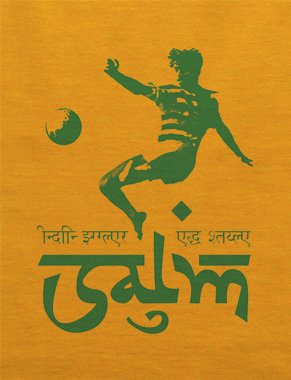
Mohammed Salim – 1937
Text (C) The Shamrock 2013
Barefooted Indian who left Calcutta to join Celtic
http://www.scotsman.com/sport/barefooted-indian-who-left-calcutta-to-join-celtic-1-1151472
GIL HERON’S death last month saw focus trained on the question of Celtic’s first black player, although correspondents to The Scotsman have been quick to make known the case of Mohammed Abdul Salim. As well as being from Calcutta, his penchant for playing without boots distinguished him further. Salim was certainly Celtic’s first Asian player.
It is hardly surprising that little is known about the forward if even in his home country his trip to Scotland is regarded as a “lost episode”. This is how a recent book, A Social History of Indian Football, described the tale of Salim, who is credited with being the first Indian to play professional football anywhere in Europe. He was unhonoured in his own country, although the issue is complicated by political circumstances, with his career coinciding with the last years of the British Raj.
A Social History of Indian Football, written by Boria Majumdar and Kausik Bandyopadhyay, seeks to “resuscitate” Salim’s place in Indian football, and explores why he faded into oblivion in his own country. Salim’s death, in November 1980, provided the spur to learn more of his achievements both at home and abroad. Indeed, his son, Rashid, revealed he contacted Celtic to highlight his father’s deteriorating health.
It seems he was not sure about his own motivation for doing so. It wasn’t for money, because when Celtic, stirred by this reminder of someone who occupies a significant place in the club’s history, sent him back 100, he was surprised. “I had no intention of asking for money. It was just a ploy to find out if Mohammed Salim was still alive in their memory,” he recalled. “To my amazement, I received a letter from the club. Inside was a bank draft for 100. I was delighted, not because I received the money but because my father still holds a pride of place in Celtic. I have not even cashed the draft and will preserve it till I die.”
Salim had been a key player as the Bengal team Mohammedan Sporting won five Calcutta league titles in a row in the 1930s. After their league success in 1936, the players took a break. But, with the Chinese Olympic side due to visit Calcutta for games against two Indian select teams, Salim was not expected to pack away his boots – or at least the bandages he wrapped around his feet in the absence of such footwear. Salim played in the first match but had disappeared by the second.
Police were instructed to look for him, and adverts placed in the local press.
It was soon learned he had left by ship for Britain, via Cairo, having been convinced by a friend that he must try his luck in British football. A few days in London were followed by a trip to Glasgow, where the pair found themselves outside Celtic manager Willie Maley’s door. “A great player from India has come by ship,” the no doubt surprised Maley was told. “Will you please take (him on trial]? But there is a slight problem. Salim plays in bare feet.”
The notion of a barefooted amateur playing among seasoned Scottish professionals might have seemed ludicrous, but Maley was prepared to look beyond the norm. A trial was arranged – though only after it had been confirmed by the Scottish Football Association that he would be allowed to play with bare feet during games – and Salim duly impressed. “(The Celtic coaches] were convinced that an exceptional talent had arrived in Scotland,” wrote Majumdar and Bandyopadhya. Maley later described him as “a Lascar seaman who scorned football boots and merely bandaged up his bare feet”.
But Salim’s time in Scotland proved short. He played only two ‘A’ (reserve) matches, hence his omission from many Celtic reference books. His first appearance came against Hamilton Accies, over whom Celtic triumphed 5-1, and the second against Galston, which was also won by a large margin – 7-1. His performances were covered by the Daily Express, where he was described as the “Indian Juggler”. The name stuck, and was the title for a poem, which recalls how a “man from India/Where traditions are steep/Stepped onto Parkhead’s hallowed turf/Wearing only bandages on his feet.”
Homesickness, combined with Salim’s desire to return to India in time for the 1937 league season, cut short his Celtic career, but, in the words of Alan Breck’s Book of Scottish Football, published in 1937, he “saw the boots off” many of his team-mates.Yet he wasn’t even the first player in Scotland to play in bare feet. This claim belongs to Tewfik Abdullah, an Egyptian who played for Cowdenbeath, and was described, in the Who’s Who of Cowdenbeath FC, as “the man who swapped the pyramids of Egypt for the coal bings of Fife”. That, though, is another story.
Mohammed Salim’s son and Mohammed Salim’s top he wore at Celtic
One of the Singapore Tims with Mohammed Salim’s Son in Kolkata with his Dad’s 1936 Celtic shirt … the first Indian to play in Europe
